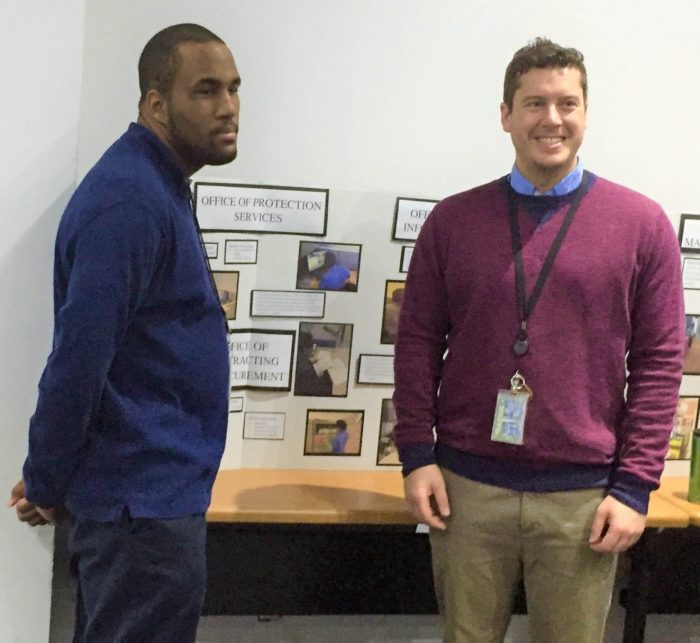Project SEARCH: Opening doors and opening minds
Looking for an enthusiastic, energetic and dedicated intern who is eager to learn and make a meaningful contribution? Search no further!
The Smithsonian has always been committed to education, and if you have been at SI long, chances are good that you have bumped into an intern or two. Interning is an excellent way to launch a career, but finding the right opportunity can be difficult. This is especially true for young people with developmental disabilities. Enter Project SEARCH.
Project SEARCH is a ten-month internship program that immerses young adults with disabilities in a professional setting. As with most SI interns, Project SEARCH participants are transitioning from school to the workplace, and hope to develop skills leading to paid employment. The program was initially developed in Cincinnati in 1996, and now includes 242 host sites in 42 states and four countries.
SI began hosting Project SEARCH interns in 2013, and the program has been beneficial for both the interns and their mentors. Each intern is carefully selected and matched with a mentor based on the needs of both the candidate and the unit. Because opportunities such as these are rare for young adults with disabilities, “our interns are typically incredibly motivated to be in the workplace,” says Ashley Grady of the Office of Accessibility.
Grady, a former teacher, oversees Project SEARCH for the Smithsonian. She hopes that the SI community can see disabled people as part of an inclusive workplace. Grady believes that “including disability under the diversity umbrella” will not only benefit disabled workers, but also the entire Smithsonian culture. “It is our hope that Project SEARCH interns can demonstrate what people with disabilities can do,” says Grady.
Host sites are never obligated to offer paid positions to program participants, but many realize the value of their interns and want to keep them on. Toby Layman, personnel manager for the Office of Facilities Management and Reliability, is looking forward to mentoring as many Project Search Interns as possible. He emphasizes the impact these young people have, saying “They’re doing real work; it helps us.”

Project SEARCH intern Ivan Leavens discusses the program with Hope Christensen, volunteer job coach with the Office of Accessibility. (Photo by Amy Stenzel)
Jenna Jones, certified volunteer administrator with Smithsonian Associates, agrees. “Hosting Project SEARCH interns increases our productivity.” Interns take on many essential tasks, freeing up volunteers to work on other, deadline-driven projects.
Several Project SEARCH interns have gone on to become full-time employees at Smithsonian, including Dovontay Taylor. Taylor started as an intern with the Office of Protection Services performing data entry; as a full-time employee he has advanced to a receptionist position, greeting visitors and providing administrative support. Mentor Dylan Garon says, “The change has been amazing,” when describing Taylor’s progress since his first day as an intern. Taylor confirms that he is happy in his current position.

Former Project SEARCH intern Dovontay Taylor, left, and mentor Dylan Garon of the Office of Protective Services. (Photo by Amy Stenzel)
The pride that the current group of interns feel in being part of the Smithsonian community is easy to see. In addition to their work assignments, Project Search interns attend a daily class in professional skills. These young people know their strengths and work actively to develop them. “I’m really good with Office and Adobe,” says intern Josh Magnus, who works on data organization in OFMR. Other interns described their diverse skills, ranging from stocking brochures to taking inventory to digitization. As part of the program, each Project SEARCH participant builds a personalized website detailing his or her work experience. OFMR intern Kevin Brown’s site is just one example. Take a look!
The Project SEARCH team provides support for not only the interns but also for their mentors. Ashley Grady and her team work with mentors every step of the way, helping units to develop an internship tailored to their specific needs. Mentors are provided with training, ongoing guidance and connection with other host sites across the Smithsonian. The Office of Accessibility even prepares all materials that accommodate an intern’s individual needs, including such things as typed instructions and schedules. Job coaches visit interns onsite to check in, noting any areas where more support is needed. Grady says that this level of engagement is working well, and that “feedback has been overwhelmingly positive from the units.”
If you are interested in becoming a Project SEARCH mentor, or know of a project that could utilize an intern, please contact Ashley Grady at GradyA@SI.edu or 202-633-4349.
Posted: 9 February 2017
-
Categories:
Collaboration , Education, Access & Outreach , Feature Stories







